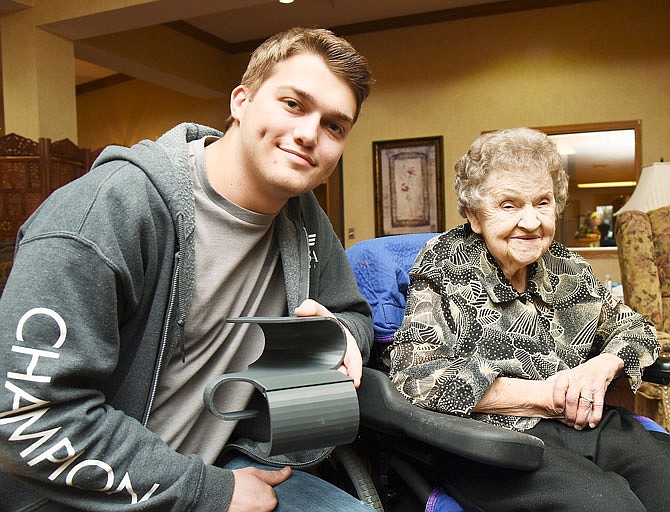Editor's Note: Dolores Forck, one of the subjects of the following story published Feb. 22, died Friday, Feb. 23, 2018. Access her obituary online here.
_
Dolores Forck, of Westphalia, had a stroke last fall. But a piece of plastic - that means so much more - is helping her recover.
Forck - who will be 83 years old Sunday - can't verbally express much at the moment.
"She knows what's going on. She's mentally there; she just can't hardly talk right now because of the stroke," her daughter, Linda Heckman, said as she visited her mom Wednesday at the Westphalia Hills Senior Living Community.
Heckman said her mom is doing physical, occupational and speech therapy, but one problem that's persisted since the stroke in November that's affected the right side of her body has been her arm. It wants to curl toward her chest and stay there, and the fingers on her right hand have a tendency to curl up.
"If it does that, then it's going to stay there. So, if we keep it out here, then we're preventing it from looking like this the rest of her life," Heckman said of the need to keep her mom's arm extended.
That was the cue for Kaleb Tuinstra, an 18-year-old Jefferson City High School senior who studies mechatronics at Nichols Career Center, where Heckman is an embedded credit coach.
Heckman said she told the mechatronics class and instructor Matt Yeager of the situation, and Tuinstra started making designs for the plastic device Forck now uses to comfortably keep her arm where it needs to be.
Mechatronics involves a variety of disciplines including 3-D printing, drafting, soldering, industrial applications and robotics.
The 3-D printed device he designed is an attachment that fits the arm mat that's a further attachment to Forck's wheelchair.
It's not a restraint, but more like a 3-D, plastic mirror image of the shape of the letter "s." The lower curve secures the device to the chair's arm, and the upper curve acts as a barrier for Forck's arm but that's still open on the other side.
The inside of the curve holding Forck's arm is lined with a computer mouse pad to help alleviate pressure points - something the second design is intended to improve upon.
"She wears this all day long, and then at night or when she sleeps we don't make her wear it," Heckman said.
"The initial one took about a week of designing and re-doing and iterations, things like that, and then she tested it out for three or four days before we came up with the second design, just to help open up the fingers," Tuinstra said Wednesday as he stood by Forck and Heckman with Yeager. The second design has an attachable guard to keep Forck's fingers where they need to be.
"We've made a couple devices like that for different situations. He's the first one in the class to make anything that was health-related," Yeager said.
"I had pictures of her arm and the seat, along with just a general 2-D sketch on a piece of paper of what we wanted each level to look like," Tuinstra said.
He then took general measurements of the arm of a girl in a another class, as she was a closer match to Forck's arm than his male classmates. He used 3-D modeling software to create the design, and then it went to a 3-D printer.
Tuinstra said he's been learning 3-D printing in his free time. It takes about eight hours to print the full device with the arm and finger guards, he added.
Forck received hers for free, but Yeager estimated it would have otherwise cost about $30-$35.
Yeager said 75 percent of the funds needed to purchase the specific 3-D printer came from a federal enhancement grant.
Tuinstra said he's offered to make a similar device for another student in Eldon.
"Last Friday, one of the guys I was competing with, he was in a wheelchair just like this, and I walked up to him and I asked him (about it) - I mentioned what we were developing. He had the exact same problem: He's losing control of his right hand, and it was clenching up. It would have worked perfectly for him."
He got the student's contact information, he added.
Yeager mentioned a similar device is in development to better serve a parent who has trouble holding their cellphone.
Tuinstra said he has a couple of friends studying medicine at Nichols who are in clinicals, working with other elderly people.
"They've seen this design, and they've given us help with general ideas. Every one of them has said, 'I wish we had one of these at ours, just for their people, just to help out.'"
He will attend Missouri University of Science and Technology at Rolla, and he hopes the institution can help patent the device.
For now, the device is still close to home, but its impact already is being felt.
"It's been exhilarating to see that I can help in the world" in practical ways, Tuinstra said.
"It means a ton to us - any little (bit) that can help, not just her but any person," Heckman said. "Anything we can do to help our little lady out. She's a trouper. She's a fighter. She's been through a lot in the past three years. Anything we can do to help, we're going to do it."

